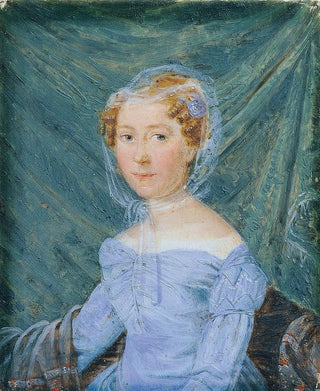Art print | Mme Theresia Rupprecht - Ferdinand Georg Waldmüller


View from behind

Frame (optional)
In the fascinating world of art, some works transcend the simple frame to become witnesses of an era, reflections of human psychology, and explorations of beauty. The art print of "Mme Theresia Rupprecht" by Ferdinand Georg Waldmüller is a perfect example. This painting, which captures the essence of a woman at the crossroads of intimacy and collectivity, invites us to immerse ourselves in an atmosphere where light, color, and gesture combine to create a delicate harmony. Waldmüller, master of portraiture, manages to immortalize not only the face of his model but also her soul, revealing the nuances of her thoughts and emotions. Through this piece, the viewer is transported into a universe where time seems suspended, where every detail matters and tells a story.
Style and uniqueness of the work
Waldmüller's style is distinguished by his ability to blend realism and romanticism, creating a unique aesthetic that is entirely his own. In "Mme Theresia Rupprecht," light plays a crucial role, illuminating the model's face in a way that evokes gentle melancholy. The colors, both rich and subtle, blend to give life to striking textures, whether in the drapes of the dress or in the softness of the hair. The artist masters the art of composition, placing the human figure at the center of a space that feels both intimate and open, as if the woman were both an element of nature and an entity in her own right. This work stands out for its ability to capture a fleeting emotion, a moment of reflection or daydreaming, inviting the viewer to question the inner world of the model.
The artist and his influence
Ferdinand Georg Waldmüller, an emblematic figure of the 19th century, knew how to mark his era with an innovative approach to portraiture. Born in 1793 in Austria, he was influenced by the artistic movements of his time while developing a personal style that allowed him to stand out. Waldmüller was a keen observer of daily life, seeking to represent subjects that resonate

Matte finish

View from behind

Frame (optional)
In the fascinating world of art, some works transcend the simple frame to become witnesses of an era, reflections of human psychology, and explorations of beauty. The art print of "Mme Theresia Rupprecht" by Ferdinand Georg Waldmüller is a perfect example. This painting, which captures the essence of a woman at the crossroads of intimacy and collectivity, invites us to immerse ourselves in an atmosphere where light, color, and gesture combine to create a delicate harmony. Waldmüller, master of portraiture, manages to immortalize not only the face of his model but also her soul, revealing the nuances of her thoughts and emotions. Through this piece, the viewer is transported into a universe where time seems suspended, where every detail matters and tells a story.
Style and uniqueness of the work
Waldmüller's style is distinguished by his ability to blend realism and romanticism, creating a unique aesthetic that is entirely his own. In "Mme Theresia Rupprecht," light plays a crucial role, illuminating the model's face in a way that evokes gentle melancholy. The colors, both rich and subtle, blend to give life to striking textures, whether in the drapes of the dress or in the softness of the hair. The artist masters the art of composition, placing the human figure at the center of a space that feels both intimate and open, as if the woman were both an element of nature and an entity in her own right. This work stands out for its ability to capture a fleeting emotion, a moment of reflection or daydreaming, inviting the viewer to question the inner world of the model.
The artist and his influence
Ferdinand Georg Waldmüller, an emblematic figure of the 19th century, knew how to mark his era with an innovative approach to portraiture. Born in 1793 in Austria, he was influenced by the artistic movements of his time while developing a personal style that allowed him to stand out. Waldmüller was a keen observer of daily life, seeking to represent subjects that resonate






